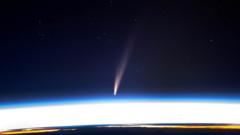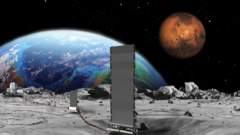Comet C/2024 G3, also known as Atlas, is set to make its debut appearance in the night sky for the first time in a staggering 160,000 years. NASA recently announced that the comet, which is currently at perihelion—the point in its orbit when it nears the sun—may be bright enough to catch the eye of stargazers by nightfall.
Astronomical predictions regarding the visibility of comets are inherently uncertain, and the team at NASA notes that while they anticipate Comet Atlas could shine as brightly as Venus, atmospheric conditions and the comet's behavior will ultimately dictate actual visibility. On Monday, the comet achieved perihelion and is anticipated to be visible starting that night.
Though specifics on prime observation sites remain unclear, experts suggest those in the southern hemisphere are likely to have the best viewing opportunities. Dr. Shyam Balaji of King's College London elaborates, noting observers should look to the eastern horizon before dawn and shift their gaze westward following sunset for optimal stargazing.
Tracking the comet's journey has captured the attention of both professional and amateur astronomers alike, with some warning that despite encouraging forecasts, many comets fail to live up to their initial brightness estimates. Northern Hemisphere residents may face challenges in spotting the comet due to its alignment with the sun.
For anyone eager to witness this once-in-a-lifetime cosmic event, experts recommend finding a location with minimal light pollution, utilizing binoculars or a small telescope, and carefully monitoring when to look up at the sky. NASA astronaut Don Pettit recently shared a stunning image of the comet captured from the International Space Station, expressing awe at witnessing such a celestial wonder from orbit.
As excitement builds for this breathtaking spectacle, enthusiasts are reminded to stay vigilant and prepared as Comet C/2024 G3 sweeps through our solar system.
Astronomical predictions regarding the visibility of comets are inherently uncertain, and the team at NASA notes that while they anticipate Comet Atlas could shine as brightly as Venus, atmospheric conditions and the comet's behavior will ultimately dictate actual visibility. On Monday, the comet achieved perihelion and is anticipated to be visible starting that night.
Though specifics on prime observation sites remain unclear, experts suggest those in the southern hemisphere are likely to have the best viewing opportunities. Dr. Shyam Balaji of King's College London elaborates, noting observers should look to the eastern horizon before dawn and shift their gaze westward following sunset for optimal stargazing.
Tracking the comet's journey has captured the attention of both professional and amateur astronomers alike, with some warning that despite encouraging forecasts, many comets fail to live up to their initial brightness estimates. Northern Hemisphere residents may face challenges in spotting the comet due to its alignment with the sun.
For anyone eager to witness this once-in-a-lifetime cosmic event, experts recommend finding a location with minimal light pollution, utilizing binoculars or a small telescope, and carefully monitoring when to look up at the sky. NASA astronaut Don Pettit recently shared a stunning image of the comet captured from the International Space Station, expressing awe at witnessing such a celestial wonder from orbit.
As excitement builds for this breathtaking spectacle, enthusiasts are reminded to stay vigilant and prepared as Comet C/2024 G3 sweeps through our solar system.



















